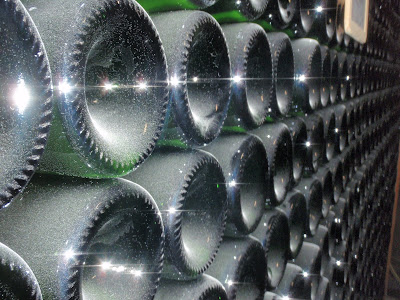I've squirreled away a few of these thick walled bad boys (a handful of magnums, one 4.5L and one 9L (!!!) knowing I wanted to eventually fill it up with my own beer, and cram a cork back inside the neck. There's discussion in the wine world that the larger format bottles are more 'age-able' and lead to a more complex and refined quaff. Perhaps it has something to do with the reduced oxygen available in the headspace/liquid ratio. Or maybe its due to the larger volume leading to a larger number and volume of flavor compound to compound interactions.
Or maybe its just because huge bottles are 100% hilariously awesome.
(yes, this is the 9L bottle of St. Feuillen tripel that the lovely wife surprised me with for Christmas a couple years back).
So, eventually I knew one day I'd dig out one of these funny bottles and fill 'er up.
Trouble was... I don't have a stand-corker that could accommodate the skyscraping height...the Colonna capper/corker that I normally use to cork and cage champagne and belgian bottles maxes out on a magnum bottle height, so after scratching that idea off the list, I was left to try to rig something with the wine kit included double lever corker.
This corker is designed for 1. wine corks (not larger diameter Belgian corks) and 2. inserting the cork flush with the top of the neck of wine bottles.
The corker has only been pressed in to service once before, and the price tag isn't staggering if it were to get injured in any wrong tool for the job attempt. So, I figured I'd do a dry run with a Belgian cork in a regular champagne bottle to see if I could overcome problem #1.
Luckily, I quickly discovered that the reducer orifice in the corker can still accomodate the larger diameter Belgian corks. I promptly removed it with a corkscrew and wondered how (if) I could mimic the same half-way-in/half-way-out insertion that I rigged with the Colonna. Feeling emboldened by my initial success, I grabbed another cork, made a quick dip in one-step sanitizer (provides just enough lubrication to help ease it through that almost too small reducer), and depressed the levers until I had plunged the cork down with the levers just slightly less than parallel to the counter. I held it up the whole apparatus to the light, and could see about 3/4 of an inch of cork in the neck.
OK...what do I do now? I would have to then interrupt the mechansim of the levers and their leverage point, but still allow the plunger to continue, otherwise the cork would just continue to get driven in to the neck, and I'd have no real way of pulling it back out, save for a CO2-seal-destroying corkscrew. I pulled the levers back a bit, and braced my left hand just under the corker's orifice chamber, right where it meets the bottle, which in effect falsely extended the neck of the bottle. Holding on tight to the bottle with my pinky and ring finger, I pushed down on the plunger directly, and with a little wiggling, the cork slipped through the remainder of the orifice, and I had that half-in/half-out cork I was looking for.
Good thing I held on to the oversized cage that came with the bottle...the regular cage wire is probably about 3 inches too short. I'm sure I could cut and twist in another length of wire, but this sure looks cleaner.
Oh, for the bottle nerds out there (oh, I'm on the only one? I don't think so.)...here's a chart of the proper names for the larger format bottles, including its correlation to the standard 750ml bottle. reference
(there are others, here's the exhaustive list from wikipedia, including the source of the bottle names)
You can just tell...there will be fun had when this bottle of Brookline hopfen weisse gets popped.
(...and no, this isn't camera trickery...the hopfen weisse is right next to that bottle of cantillon to its left).






























